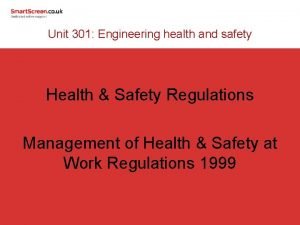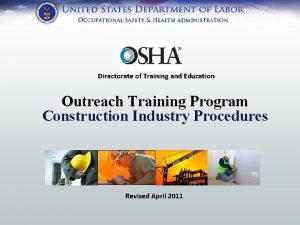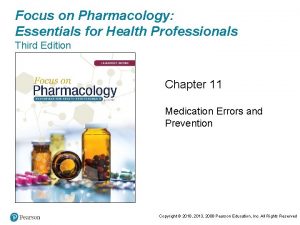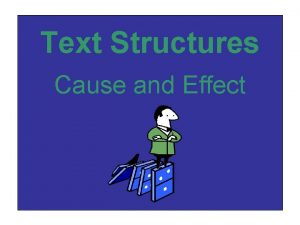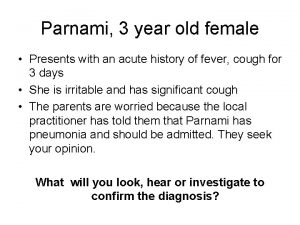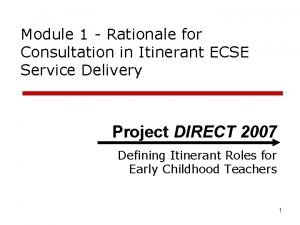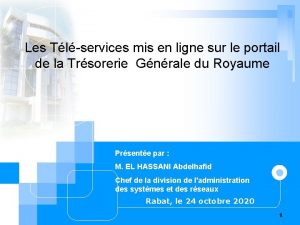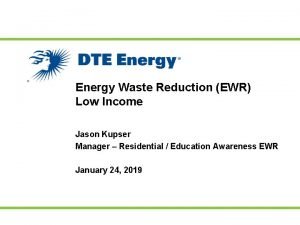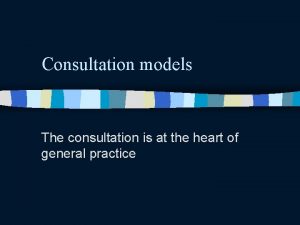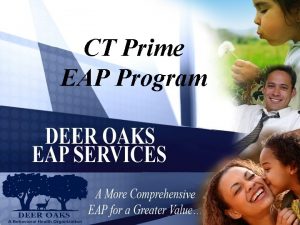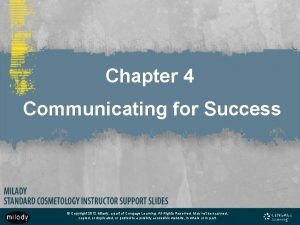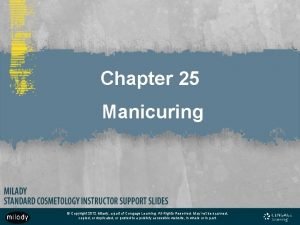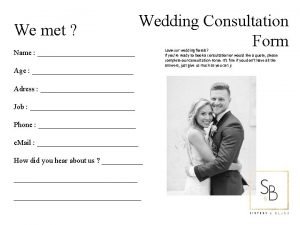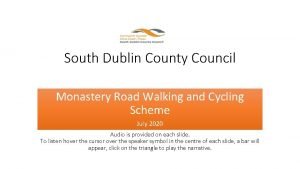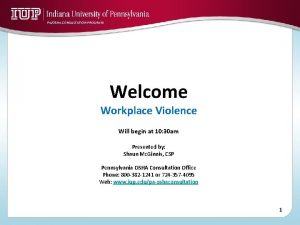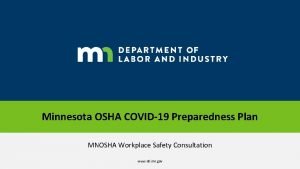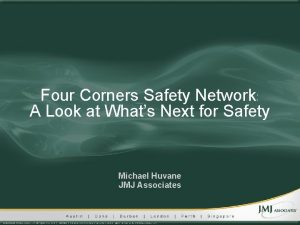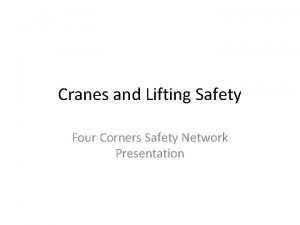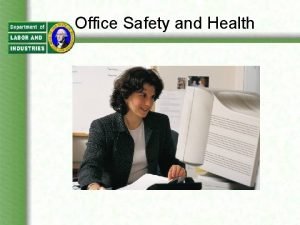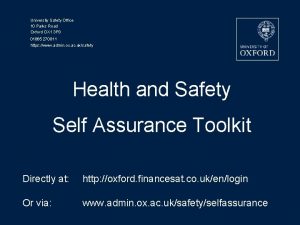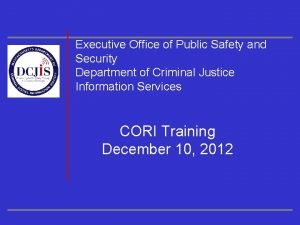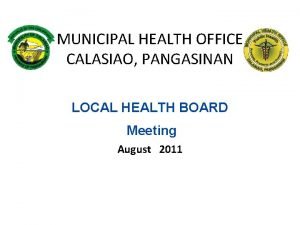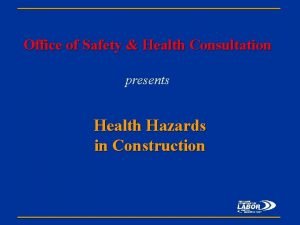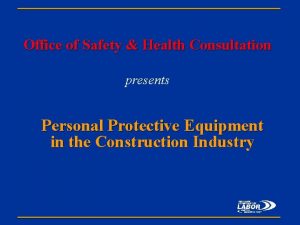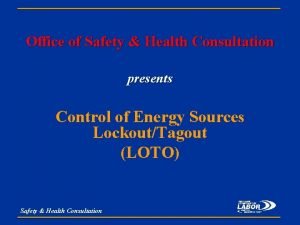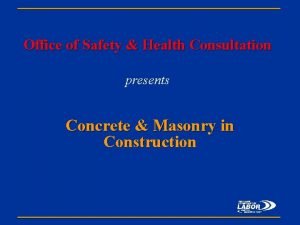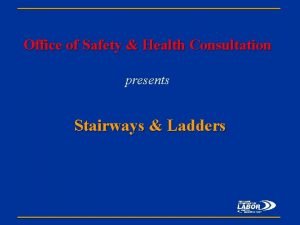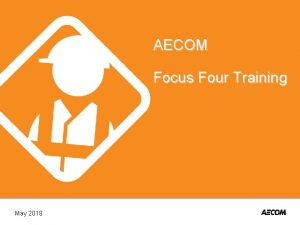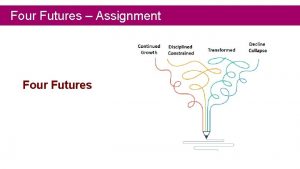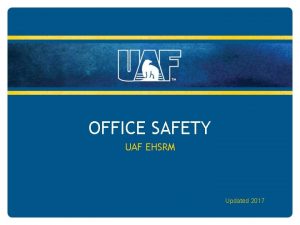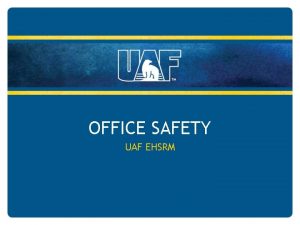Office of Safety Health Consultation presents Focus Four



















































































- Slides: 83

Office of Safety & Health Consultation presents Focus Four Fall Protection in Construction

Objectives In this course, we will discuss the following: • Emphasis on fall protection • Subpart M requirements • Applying fall protection standards to construction sites

Subpart and Standard 1926. Number of Serious Violations – FY 2013 Subpart M Fall Protection (1926. 500 - 503) 3

Subpart M – Fall Protection • Exception – Covers all fall hazards except specific requirements found in: • • • Subpart L – Scaffolds Subpart R – Steel erection Subpart S – Tunneling operations Subpart V – Power transmission and distribution Subpart X – Stairways and ladders Subpart CC –Cranes and derricks 1926. 500 -503

Subpart M – Fall Protection • Exception – The provisions of this subpart do not apply when employees are making an inspection, investigation, or assessment of workplace conditions prior to the actual start of construction work or after all construction work has been completed. 1926. 500(a)(1)

Fall Exposure: Then and now. . . • 1969 Construction Est. fall exposure – Drip edge = 11′ – Roof peak = 16′ • 2008 Construction Est. fall exposure – Drip edge = 23′ – Roof peak = 38′

Fall Protection Requirements Steel Erection 15’ Scaffolds 10’ Construction Sites 6’ General Industry 4’

Duty to Have Fall Protection • Employer required to provide fall protection systems. • Employer shall determine if the walking/working surfaces on which its employees are to work have the strength and structural integrity to support employees safely. 1926. 501(a)

Should He Have Fall Protection?

Fall Protection Required • Unprotected sides, edges • Overhand bricklaying • Leading edges • Low-slope roofs • Hoist areas • Steep roofs • Holes • Pre-cast concrete erection • Formwork, reinforcing steel • Residential construction • Ramps, runways • Wall openings • Excavations • Other walking and working surfaces • Dangerous equipment 1926. 501(b)(1)-(15)

Fall Protection Required • Unprotected sides, edges 1926. 501(b)(1)

Fall Protection Required • Leading edges 1926. 501(b)(2)

Fall Protection Required • Hoist areas 1926. 501(b)(3)

Fall Protection Required • Holes – Includes skylight floor openings 1926. 501(b)(4)

Fall Protection Required • Formwork and reinforcing steel 1926. 501(b)(5)

Fall Protection Required • Ramps, runways, other walkways 1926. 501(b)(6)

Fall Protection Required • Excavations 1926. 501(b)(7)

Fall Protection Required • Dangerous equipment 1926. 501(b)(8)

Fall Protection Required • Overhand bricklaying 1926. 501(b)(9)

Fall Protection Required • Low-slope roof – < 4/12 pitch • Steep roof – > 4/12 pitch 1926. 501(b)(10) &(11)

Fall Protection Required • Pre-cast concrete erection 1926. 501(b)(12)

Fall Protection Required • Residential construction 1926. 501(b)(13)

Fall Protection Required • Wall openings 1926. 501(b)(14)

Fall Protection Required • Other walking/working surfaces 1926. 501(b)(15)

Fall Protection Is this correct?

Falling Objects • Each exposed employee shall wear a hardhat. • Employer must take steps to prevent employees from being hit by falling objects. – Erect toe boards, screens, or guardrail systems – Erect a canopy structure – Barricade the area 1926. 501(c)

Methods of Fall Protection • Conventional methods – Safety nets – Guardrails – Personal fall arrest systems (PFAS) Safety net 1926. 502(a)(1)

Guardrail System 1926. 502(b)

Guardrail System Top rail: 42′′ +3′′ Midrail: 21′′ +3′′ Note: Toe boards are not part of a guardrail system for fall protection 1926. 502(b)

Guardrails Job well done

Personal Fall Arrest System No slack

Personal Fall Arrest System Lots of slack! Only one attachment point!

Personal Fall Arrest System Is this correct?

Personal Fall Arrest System Anchorage Connectors Harness 1926. 503(d)

Personal Fall Arrest System • D-Rings, snaphooks, lanyards, lifelines, anchorages rated @ 5, 000 pounds • No free fall more than 6′; nor contact any lower level; 3. 5′ max deceleration • Provide for prompt rescue • Inspect prior to each use 1926. 502(d)

Personal Fall Arrest System

Personal Fall Arrest System

Personal Fall Arrest System • Body belts not allowed for fall arrest but may be used as a positioning device • Only locking type of snaphook can be used

Positioning Device System • Allows an employee to be supported on an elevated vertical surface • No more than 2′ freefall • Inspected before each use • Safety belts okay for use 1926. 502(e)

Methods of Fall Protection • Other acceptable methods – Used under certain circumstances • Warning lines • Control access zones (CAZ) • Safety monitor • Fall protection plan 1926. 502(f)

Warning Lines • Used on low-sloped roofs < 4/12 • Erect 6′ from all edges • Need fall protection for last 6′ • Used in combination with other systems • Developed by competent 1926. 502(f), 502(b)(10) person

Controlled Access Zones • Used in: – Leading edge work – Overhand bricklaying – Pre-cast concrete • Only authorized persons 1926. 502(g)

Safety Monitor System • Used on low-sloped roofs < 4/12 • With roof widths < 50’, can use alone • Monitor must be competent person – No other responsibilities 1926. 502(h)

Fall Protection Plan • Only for specific area or jobs – Leading edge work – Precast concrete erection work – Residential construction work • Used when conventional fall protection equipment is infeasible or creates a greater hazard • Designed by qualified person • Supervised by competent person 1926. 502(k)

Covers for Holes • Covers shall: – Withstand two times weight of expected load – Secured to prevent displacement – Marked “hole” or “cover” or color-coded 1926. 502(i)

Protection from Falling Objects • Toeboards – When used as falling object protection, shall be erected along the edge of the overhead walking/working surface – Withstand force of at least 50 pounds – Toeboards shall be a minimum of 3 ½ inches in vertical height 1926. 502(j)

Training Requirements • The employer shall: – Provide training program – Assure each employee has been trained – Provide written certification – Retrain where necessary 1926. 503

Now let’s test what you have learned…

Personal Fall Arrest Systems Is this correct?

Personal Fall Arrest Systems Is this correct?

Personal Fall Arrest Systems Is this correct?

Personal Fall Arrest Systems Is this correct?

Personal Fall Arrest Systems Is this correct?

Covers Is this correct?

Guardrails Is this correct?

Guardrails Is this correct?

Guardrails Is this correct?

Summary In this course, we discussed: • Emphasis on fall protection • Subpart M requirements Fall Protection • Applying fall protection standards to construction sites

Is This a Fall Hazard? 59 59

YES Workers could fall while climbing on the shoring structure to set it up and remove it. Ladders and lifts must be provided. 60 60

Any Fall Hazard Here? 61 61

YES Workers are exposed to a fall hazard greater than 6 feet, while working near stairwell opening. Workers must be protected from falls over 6 feet. 62 62

Is This a Fall Hazard? 63 63

YES Unprotected open-sided floors 6 feet or more above ground level. Guardrail systems, safety net systems or personal fall arrest systems are required. 64 64

Any Fall Hazard Here? 65 65

YES Workers are installing a new metal roof without fall protection. NOTE: Remember that ladders must extend 3 feet above the landing area. 66 66

Is This a Fall Hazard? 67 67

YES The photo shows a mid-rail and toeboard are missing on an open-sided floor of a building. This could expose workers to a 12 foot fall. Toeboards are required to protect workers below from falling objects. 68 68

Can You Identify the Fall Hazard? 69 69

YES Lack of fall protection for workers on fabricated frame scaffolds. Planks appear to be overloaded and there is no safe access for workers. The workers are exposed to a 35 -foot fall hazard from a scaffold while stacking blocks prior to overhand bricklaying operations. 70 70

Can You Identify the Fall Hazard? 71 71

YES Ladder to work platform is not of sufficient length. It must extend 3 feet above the working surface. 72 72

Is This a Fall Hazard? 73 73

YES Worker is working off of the top of a step ladder. The top of a stepladder shall not be used as a step. 74 74

Can You Identify the Fall Hazards? 75 75

A worker is working from a carpenters' scaffold that has no guardrail, extends too far beyond either end, and is not wide enough. YES The worker inside of the window is not provided with fall protection as there is no standard guardrail for the window. The worker also does not have proper access to the scaffold. The worker working below is exposed to the struck-by hazards of tools and equipment falling from the employees working above. NOTE: A competent person must supervise as scaffolds are erected, moved and taken apart. 76 76

Any Fall Hazard Here? 77 77

YES Workers working on balcony of structure exposed to fall hazard due to unprotected side/edge. 78 78

Is This a Fall Hazard? 79 79

YES Worker working on an 8: 12 pitch roof with only the lifeline tied to his waist as fall protection. Employer must provide full body harnesses. 80 80

Is This a Fall Hazard? 81 81

YES Scaffold was not erected with guardrails in areas where workers were working at heights greater than 10 feet. 82 82

Your Questions?
 Caplan's four types of consultation
Caplan's four types of consultation Language
Language Porter's generic strategies
Porter's generic strategies Business level strategy cost leadership
Business level strategy cost leadership Actor focus vs object focus
Actor focus vs object focus Unit 301
Unit 301 Osha focus four quickcard
Osha focus four quickcard Document analysis declaration of independence
Document analysis declaration of independence Focus on pharmacology essentials for health professionals
Focus on pharmacology essentials for health professionals Focus on pharmacology essentials for health professionals
Focus on pharmacology essentials for health professionals Presents cause and effect relationships
Presents cause and effect relationships Presents from my aunt in pakistan
Presents from my aunt in pakistan Presents from my aunt in pakistan
Presents from my aunt in pakistan Sally elatta presents on business agility
Sally elatta presents on business agility 16 3 darwin presents his case answer key
16 3 darwin presents his case answer key 16 3 darwin presents his case answer key
16 3 darwin presents his case answer key Zids and zods answers
Zids and zods answers Discussion text structure
Discussion text structure Zids tool
Zids tool Prose writing that presents and explains ideas
Prose writing that presents and explains ideas What is nonfiction prose
What is nonfiction prose Zids and zods
Zids and zods Shona quiz
Shona quiz Quand je t'ouvre mon coeur je te vois seigneur
Quand je t'ouvre mon coeur je te vois seigneur Thesis statement and main idea
Thesis statement and main idea A 26 year old female presents
A 26 year old female presents This presents
This presents A dramatic work that presents the downfall of a character
A dramatic work that presents the downfall of a character Structure of a drama
Structure of a drama Sue palmer discussion book
Sue palmer discussion book Shcedules
Shcedules Is the way an author presents a character.
Is the way an author presents a character. Which type of communication is shown in this poster
Which type of communication is shown in this poster A thesis statement presents
A thesis statement presents Which sentence presents a faulty either/or argument?
Which sentence presents a faulty either/or argument? Chapter 17 neurologic emergencies
Chapter 17 neurologic emergencies Coverage consultation grafton
Coverage consultation grafton Triadic consultation model
Triadic consultation model Trésorerie générale du royaume banque en ligne
Trésorerie générale du royaume banque en ligne Dte home energy consultation
Dte home energy consultation Consultation skills for pharmacy practice
Consultation skills for pharmacy practice Consultation models
Consultation models Helman consultation model
Helman consultation model Triadic dependent model
Triadic dependent model Balint consultation model
Balint consultation model Www.consultationskillsforpharmacy.com
Www.consultationskillsforpharmacy.com Bradford vts consultation models
Bradford vts consultation models Deer oaks consultation services
Deer oaks consultation services Behavioral consultation
Behavioral consultation Chapter 4 milady
Chapter 4 milady Wooden pusher definition cosmetology
Wooden pusher definition cosmetology Home buyer consultation
Home buyer consultation Wedding consultation form
Wedding consultation form Consultation skills for pharmacy practice
Consultation skills for pharmacy practice Balint consultation model
Balint consultation model Service delivery consultation
Service delivery consultation Consultation collocation
Consultation collocation Dr hamza andreea
Dr hamza andreea Sdcc consultation portal
Sdcc consultation portal Pa osha consultation
Pa osha consultation Mn osha consultation
Mn osha consultation Pendleton consultation model
Pendleton consultation model Microslide consultation
Microslide consultation Four sides and four corners
Four sides and four corners 4 eyes assessment
4 eyes assessment Factory office plan
Factory office plan Safe stand for in food
Safe stand for in food Jmj qatar
Jmj qatar Four corners safety
Four corners safety Hazard
Hazard Oxford university safety office
Oxford university safety office üdc
üdc Page 38
Page 38 Where do you activate the four shades function
Where do you activate the four shades function Safety care behavioral safety training
Safety care behavioral safety training Process safety vs personal safety
Process safety vs personal safety Safety assessment for ind safety reporting
Safety assessment for ind safety reporting Basic safety orientation
Basic safety orientation Construction site safety orientation
Construction site safety orientation Four components of psychological health
Four components of psychological health Identify the cornerstones of the wellness movement
Identify the cornerstones of the wellness movement Office of health standards compliance
Office of health standards compliance Calasiao municipal health office
Calasiao municipal health office Office of minority health resource center
Office of minority health resource center





